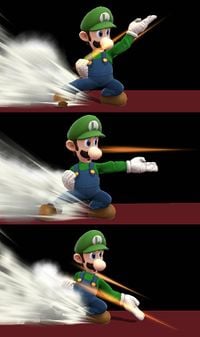Angling
Angling (officially known as shifting) is the ability for a character to alter the direction of a forward tilt or forward smash. For example, angling a punch attack up will generally cause the character to punch diagonally upwards instead of straight forward, while angling it down will tend to cause the character to punch diagonally downwards. Additionally, most attacks will deal slightly altered damage amounts when angled, with attacks typically dealing 1-2% more damage when angled up, and 1% less damage when angled down (though some attacks deviate from this). On the whole, attacks can only be angled if they are a straight punch, kick, or similar strike; attacks that cover vertical ground (such as an overhead sword slash) have no purpose for angling.
Angling attacks downwards can aid in striking short or crouching characters such as Pikachu or Kirby in cases where the regular attack would miss just overhead, but most attacks deal slightly less damage when angled down as mentioned previously. Angling upwards is useful for intercepting aerial characters and often comes with the aforementioned slight damage bonus, but the aforementioned short characters will be even more able to avoid it. Angling can also help with edgeguarding; Ganondorf's and Falco's forward tilts in Melee are prime examples of forward tilts that are more useful at guarding the area around the edge when angled down.
To angle a forward tilt, the player must hold the control stick diagonally up or down when inputting the tilt. Angling forward smashes works differently, and depends on the game. In Melee, angling smash attacks is somewhat difficult; the player has to hold the direction of the C-Stick or control stick at a precise angle between forward and diagonally while inputting the forward smash (which the GameCube controller's control sticks have no indentation for, making it even more difficult). Holding the sticks diagonally up or diagonally down inputs an up smash or down smash instead of an angled forward smash (unlike with tilts). From Brawl onward, the player can angle forward smashes by holding up/down immediately after initiating it (or while charging the smash), making it significantly easier and simpler to do. Using the Wii Remote, it is impossible to angle a forward tilt upwards without an input earlier for the same reason as an up tilt (due to lack of a control stick); however, it is possible to execute a downwards forward tilt by crouching first and using a forward tilt while getting up.
Attacks that can be angled generally have three possible angles: up, side (or neutral), and down. In Smash 64, some attacks have up to 5 angles.
List of attacks that can be angled
Notes
- ^ a b In Ultimate, the weapon used for Peach and Daisy's forward smash depends on the angle. Angling forward (no angle) uses the golf club, which has longer reach; angling upward uses the frying pan, which deals more damage; and angling downward uses the tennis racket, which is a semi-spike.
- ^ a b Little Mac's forward smash becomes different types of attacks when angled. Angling forward (no angle) is a straight punch, angling up is an uppercut with more vertical knockback, and angling down is a body hook that deals low knockback but high damage and shield damage.
- ^ a b In Ultimate, Marth and Lucina can angle their neutral special.
- ^ a b In Melee, Mario and Luigi's forward tilts deal very weak set knockback at the Sakurai angle when angled down.
- ^ In Brawl, Luigi's forward tilt deals no knockback when angled down.
- ^ In Brawl, Luigi's forward smash has additional IASA frames when angled up, making it more difficult to punish. The move also does higher damage (and therefore knockback), making the move's already very strong knockback scaling especially immense.
- ^ a b Simon and Richter can angle their forward aerial and back aerial attacks as well.
